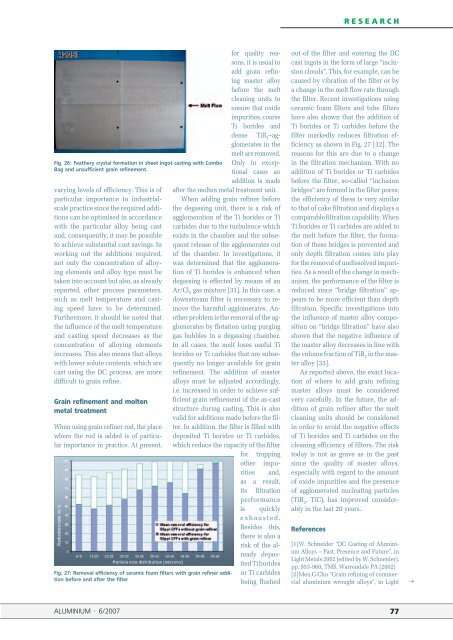Sie wollen auch ein ePaper? Erhöhen Sie die Reichweite Ihrer Titel.
YUMPU macht aus Druck-PDFs automatisch weboptimierte ePaper, die Google liebt.
Fig. 26: Feathery crystal formation in sheet ingot casting with Combo<br />
Bag and unsufficient grain refinement.<br />
varying levels of efficiency. This is of<br />
particular importance to industrialscale<br />
practice since the required additions<br />
can be optimised in accordance<br />
with the particular alloy being cast<br />
and, consequently, it may be possible<br />
to achieve substantial cost savings. In<br />
working out the additions required,<br />
not only the concentration of alloying<br />
elements and alloy type must be<br />
taken into account but also, as already<br />
reported, other process parameters,<br />
such as melt temperature and casting<br />
speed have to be <strong>de</strong>termined.<br />
Furthermore, it should be noted that<br />
the influence of the melt temperature<br />
and casting speed <strong>de</strong>creases as the<br />
concentration of alloying elements<br />
increases. This also means that alloys<br />
with lower solute contents, which are<br />
cast using the DC process, are more<br />
difficult to grain refine.<br />
Grain refinement and molten<br />
metal treatment<br />
When using grain refiner rod, the place<br />
where the rod is ad<strong>de</strong>d is of particular<br />
importance in practice. At present,<br />
ALUMINIUM · 6/2007<br />
for quality reasons,<br />
it is usual to<br />
add grain refining<br />
master alloy<br />
before the melt<br />
cleaning units to<br />
ensure that oxi<strong>de</strong><br />
impurities, coarse<br />
Ti bori<strong>de</strong>s and<br />
<strong>de</strong>nse TiB 2 –agglomerates<br />
in the<br />
melt are removed.<br />
Only in exceptional<br />
cases an<br />
addition is ma<strong>de</strong><br />
after the molten metal treatment unit.<br />
When adding grain refiner before<br />
the <strong>de</strong>gassing unit, there is a risk of<br />
agglomeration of the Ti bori<strong>de</strong>s or Ti<br />
carbi<strong>de</strong>s due to the turbulence which<br />
exists in the chamber and the subsequent<br />
release of the agglomerates out<br />
of the chamber. In investigations, it<br />
was <strong>de</strong>termined that the agglomeration<br />
of Ti bori<strong>de</strong>s is enhanced when<br />
<strong>de</strong>gassing is effected by means of an<br />
Ar/Cl 2 gas mixture [31]. In this case, a<br />
downstream filter is necessary to remove<br />
the harmful agglomerates. Another<br />
problem is the removal of the agglomerates<br />
by flotation using purging<br />
gas bubbles in a <strong>de</strong>gassing chamber.<br />
In all cases, the melt loses useful Ti<br />
bori<strong>de</strong>s or Ti carbi<strong>de</strong>s that are subsequently<br />
no longer available for grain<br />
refinement. The addition of master<br />
alloys must be adjusted accordingly,<br />
i.e. increased in or<strong>de</strong>r to achieve sufficient<br />
grain refinement of the as-cast<br />
structure during casting. This is also<br />
valid for additions ma<strong>de</strong> before the filter.<br />
In addition, the filter is filled with<br />
<strong>de</strong>posited Ti bori<strong>de</strong>s or Ti carbi<strong>de</strong>s,<br />
which reduce the capacity of the filter<br />
for trapping<br />
other impurities<br />
and,<br />
as a result,<br />
its filtration<br />
performance<br />
is quickly<br />
exhausted.<br />
Besi<strong>de</strong>s this,<br />
there is also a<br />
risk of the already<strong>de</strong>posited<br />
Ti bori<strong>de</strong>s<br />
or Ti carbi<strong>de</strong>s<br />
being flushed<br />
RESEARCH<br />
out of the filter and entering the DC<br />
cast ingots in the form of large “inclusion<br />
clouds”. This, for example, can be<br />
caused by vibration of the filter or by<br />
a change in the melt flow rate through<br />
the filter. Recent investigations using<br />
ceramic foam filters and tube filters<br />
have also shown that the addition of<br />
Ti bori<strong>de</strong>s or Ti carbi<strong>de</strong>s before the<br />
filter markedly reduces filtration efficiency<br />
as shown in Fig. 27 [32]. The<br />
reasons for this are due to a change<br />
in the filtration mechanism. With no<br />
addition of Ti bori<strong>de</strong>s or Ti carbi<strong>de</strong>s<br />
before the filter, so-called “inclusion<br />
bridges“ are formed in the filter pores;<br />
the efficiency of these is very similar<br />
to that of cake filtration and displays a<br />
comparable filtration capability. When<br />
Ti bori<strong>de</strong>s or Ti carbi<strong>de</strong>s are ad<strong>de</strong>d to<br />
the melt before the filter, the formation<br />
of these bridges is prevented and<br />
only <strong>de</strong>pth filtration comes into play<br />
for the removal of undissolved impurities.<br />
As a result of the change in mechanism,<br />
the performance of the filter is<br />
reduced since “bridge filtration” appears<br />
to be more efficient than <strong>de</strong>pth<br />
filtration. Specific investigations into<br />
the influence of master alloy composition<br />
on “bridge filtration” have also<br />
shown that the negative influence of<br />
the master alloy <strong>de</strong>creases in line with<br />
the volume fraction of TiB 2 in the master<br />
alloy [33].<br />
As reported above, the exact location<br />
of where to add grain refining<br />
master alloys must be consi<strong>de</strong>red<br />
very carefully. In the future, the addition<br />
of grain refiner after the melt<br />
cleaning units should be consi<strong>de</strong>red<br />
in or<strong>de</strong>r to avoid the negative effects<br />
of Ti bori<strong>de</strong>s and Ti carbi<strong>de</strong>s on the<br />
cleaning efficiency of filters. The risk<br />
today is not as grave as in the past<br />
since the quality of master alloys,<br />
e<strong>special</strong>ly with regard to the amount<br />
of oxi<strong>de</strong> impurities and the presence<br />
of agglomerated nucleating particles<br />
(TiB 2 , TiC), has improved consi<strong>de</strong>rably<br />
in the last 20 years.<br />
References<br />
[1] W. Schnei<strong>de</strong>r “DC Casting of <strong>Alu</strong>minium<br />
Alloys – Past, Presence and Future”, in<br />
Light Metals 2002 (edited by W. Schnei<strong>de</strong>r),<br />
pp. 953-960, TMS, Warrendale PA (2002)<br />
[2] Men.G.Chu “Grain refining of commercial<br />
aluminium wrought alloys”, in Light<br />
Fig. 27: Removal efficiency of ceramic foam filters with grain refiner addition<br />
before and after the filter �<br />
77

















